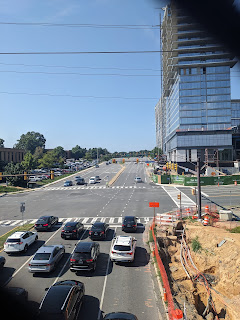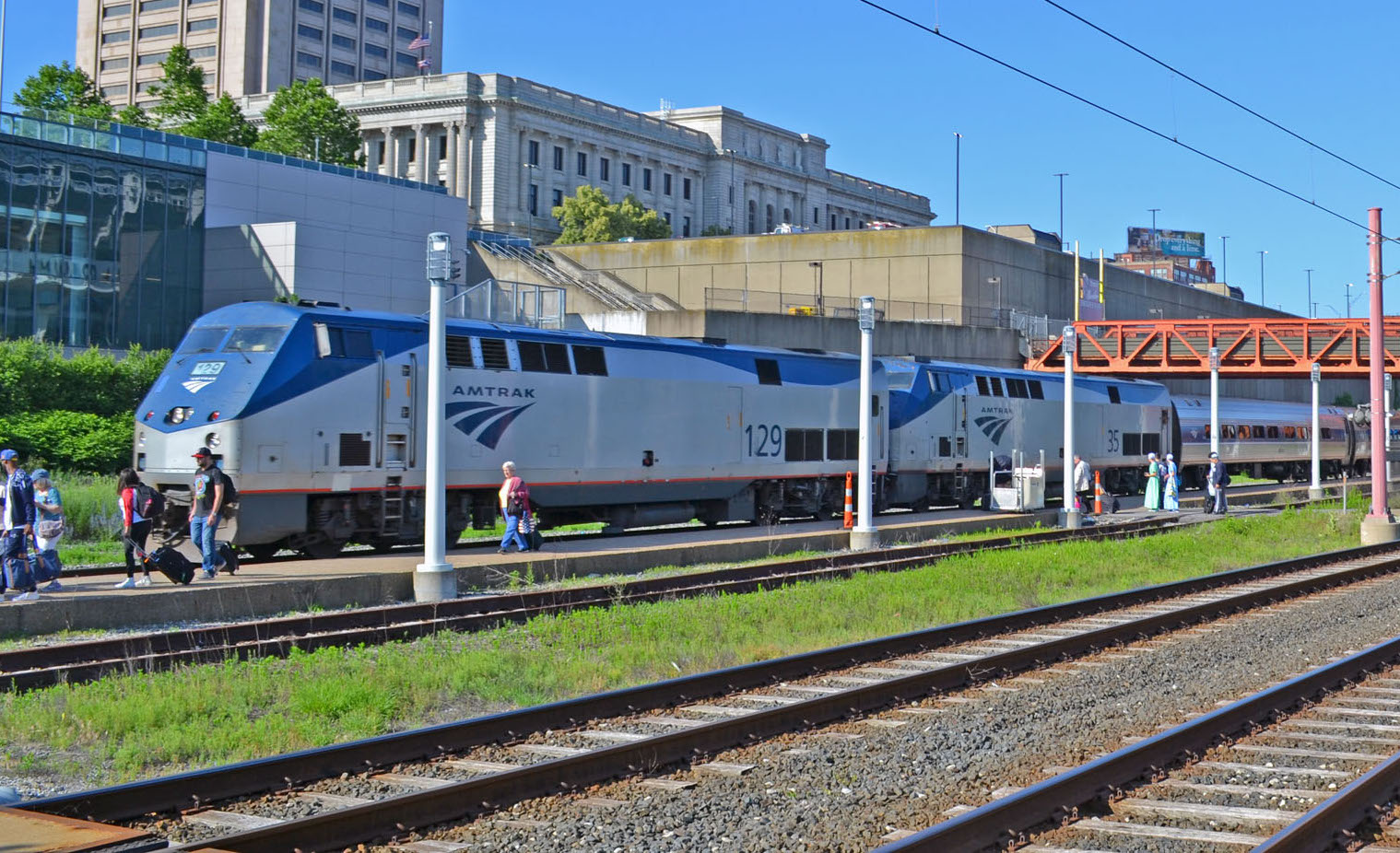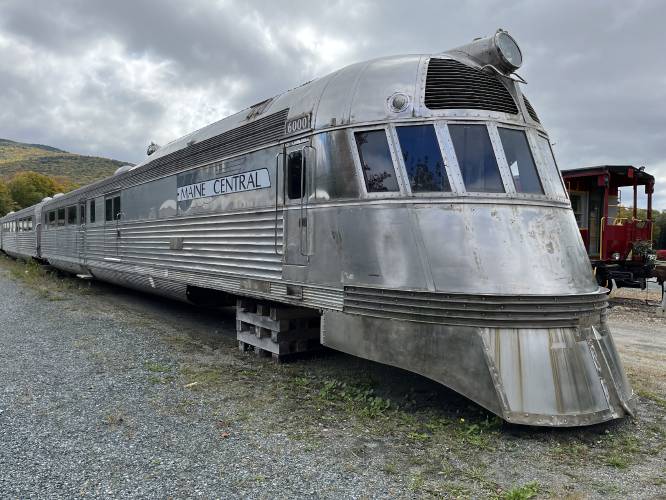This past year showed the importance of celebrating our wins. A number of important bicycle infrastructure projects have opened across the region. Feel free to leave a comment about which projects I missed, especially ones in Montgomery County or Prince Georges County.
Alexandria
 |
| King St protected bike lanes |
 |
| Potomac Yard Trail spur |
I may have missed this from 2023 but on Oronoco St, a bicycle only left turn lane was added. This allows people biking to turn into the Mount Vernon Trail. I have not seen anything like it elsewhere.
 |
| Bicycle left turn lane |
The Monroe St bike lanes finally got short protection to deter drivers from using them to bypass speed bumps. The initial bumps where built six inches too tall but even after they were shaved down and the bike lane got green paint, drivers still treated them like passing lanes.
 |
| Monroe St's protected speed humps |
A short half block of King St got a protected bike lane in one direction to improve access to the King St Metro. An unprotected bike lane was added just east of it and a westbound bike lane and bike box were also added. While currently disconnected, construction will soon get underway to replace a 100 year old railroad bridge, which when completed, will provide space for protected bike lanes.
Arlington County
Wilson Blvd has had a protected bike lane since 2016 but it stopped about two blocks short of N Veitch St protected bike lanes. That gap has finally been filled and includes a wider sidewalk to boot.
 |
| Wilson Blvd's protected bike lane |
While just one block, the N Lynne St bike lane long been among Arlington’s most blocked. Any number of food delivery drivers, ride hailing and taxis, delivery trucks and an official intercity bus stop would force people biking into a four lane street. For folks coming off of the Arlington Blvd Trail or the Route 110 Trail, this link will provide a much safer connection to the Mt Vernon Trail, Custis Trail and Key Bridge.
A new bridge opened across Four Mile Run, augmenting a narrow sidewalk section on S Shirlington Rd. It also provides direct access to Jennie Dean Park.
 |
| Four Mile Run Bridge to Jennie Dean Park |
A short section of 18th St S reopened with protected bike lanes from S Eads St to S Fern St, connecting Arlington's first protected bike lane with S Eads St's PBL and the Crystal City Metro.
 |
| 18th St S protected bike lanes |
The 1800 block Crystal Dr received a southbound protected bike lane as did a block of Clarendon Blvd near Courthouse Metro.
Fairfax County
Full disclosure, I work for Fairfax County on bicycle and pedestrian projects.
For people walking and bicycling on the W&OD Trail, one of the worst crossings has been Wiehle Ave in Reston. The trail crossed midblock just north of the multi-lane Sunset Hills Rd intersection. Wiehle Ave itself widens from four lanes to six just for this intersection and widens again to 12 lanes. Drivers fly off of the Dulles Toll Rd and do not expect to stop for people in the crosswalk, causing numerous injuries for trail users. Thankfully, the Wiehle Nice New bridge opened in July, allowing people riding and walking to soar over that nonsense. 
View from new Wiehle Ave Bridge
of former Wiehle Ave grade crossing
Fairfax County has not repurposed parking for bike lanes in a meaningful way until Anderson Rd. This street divides an aging apartment complex on either side, a grocery store and newer condos and townhomes, all just a short ride from the McLean Metro. Most of the parking has been removed except for a short downhill section.
 |
| Anderson Rd buffered bike lanes |
 |
| Laurel Hill Dr's buffered bike lanes |
The National Park Service also replaced the Mount Vernon Trail's Dyke Marsh bridge. The bumpy, loud ride is now slightly wider, much smoother and quieter.
 |
| Mount Vernon Trail bridge over Dyke Marsh |
Washington, DC
DDOT has a helpful list of projects completed by year. A close contender with N Lynne St for one of the region’s most blocked bike lanes, Columbia Rd NW’s bike lanes had faded and were constantly blocked by the same sorts of drivers. Thankfully, DDOT leveraged repaving to remove most street parking to add protected bike lanes, concrete islands to help people cross the street, and even added few short bus lanes.
11th St NW received protected bike lanes in its downtown section, running from Pennsylvania Ave to Massachusetts Ave for 0.6 miles. Not only will this link help revitalize downtown DC, there is an extension planned to Columbia Heights.
I rode on I (eye) St SW for several years as my primary commute route. While it lacked the thrill of N Lynne St and Columbia Rd NW’s frequent bike lane parkers, parents dropping their kids at an elementary school would occasionally make u turns into my path. Drivers at the S Capitol St intersection also had a nasty habit of swerving into people biking across the street, thanks to a combined left/straight lane that encouraged eastbound drivers to go around fellow drivers turning left. Now, people biking have a protected lane and a green wave, meaning a cyclists traveling 12 mph will hit all green lights, a regional first! This is a key east-west link between Maine Ave and Virginia commuters and employers in the Navy Yard.
The Capital Crescent Trail has long been one of the region’s main bicycle routes, connecting Bethesda with Georgetown. However since it follows the Potomac River’s steep embankment, it has few connections to other DC neighborhoods. Now, the Palisades are connected via a two-way cycletrack on Arizona Ave NW. This also puts American University a short ride away from the Capital Crescent Trail. Cyclists must use a short dirt section to get from the trail to the cycletrack but hopefully, a direct connection will be formalized in the future.
After a bike repair this fall, my toddler and I took the new 19th St NE/SE cycletrack home. It provides a north-south link across the Eastern side of Capitol Hill, connecting directly to the Anacostia Riverwalk Trail and the Stadium Armory Metro.
 |
| 19th St NE cycletrack |
In summer 2019, Dave Salovesh was stopped a red light on Florida Ave NE when a driver of a stolen van killed him while fleeing police. Dave was well-known for his cycling advocacy. DDOT implemented a quick build cycletrack on Florida Ave a few months later. Overtime, those materials fell apart and one day, a construction crew even left a large saw blade in the cycletrack itself. Thankfully, the street was repaved and the cycletrack was replaced with two concrete barrier protected bike lanes that run under the railroad tracks to 2nd St NE. A short walk up a runnel or ride up an elevator connects riders to the Metropolitan Branch Trail.
 |
| Florida Ave NE protected bike lanes |
Technically, M St SE was rideable in late 2023 but it was not officially completed until January. M St was a six lane highway and not long after the US DOT opened its Navy Yard headquarters, several employees died trying to cross it. I rarely rode it for that reason and always dreaded crossing it. But along the south side, there is now a cycletrack and just two travel lanes and just one in the other direction. A bus lane and left turn lane have replaced the other lanes, transforming the street into a far safer place, right next to DDOT and USDOT’s offices as well as numerous transportation contractors.
 |
| M St SE cycletrack |
Lastly, 2024 marks ten years of living in the DMV for me. At that time, all we had for protected bike lanes was L St, M St and 15th St NW, nothing beyond DC. While the day to day pace of change may seem slow, our bike network has grow in leaps and bounds across multiple jurisdictions in only ten years, fairly short for transportation planning. We have gotten faster at implementation, have much better guidance to build the right stuff and have a whole generation of politicians, planners and engineers creating momentum for the next decade. Enjoy the ride!








